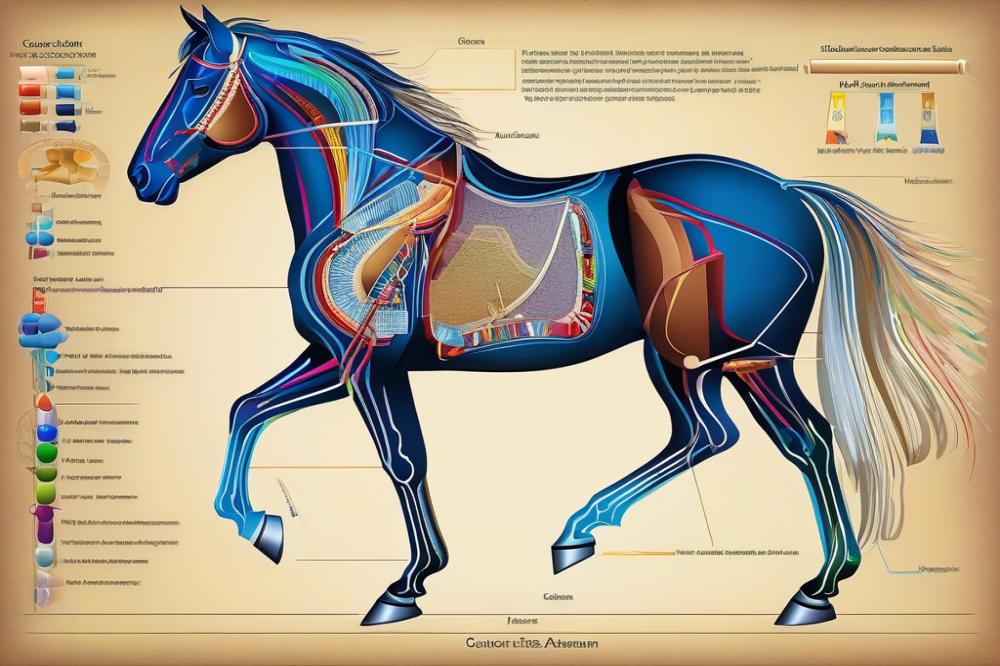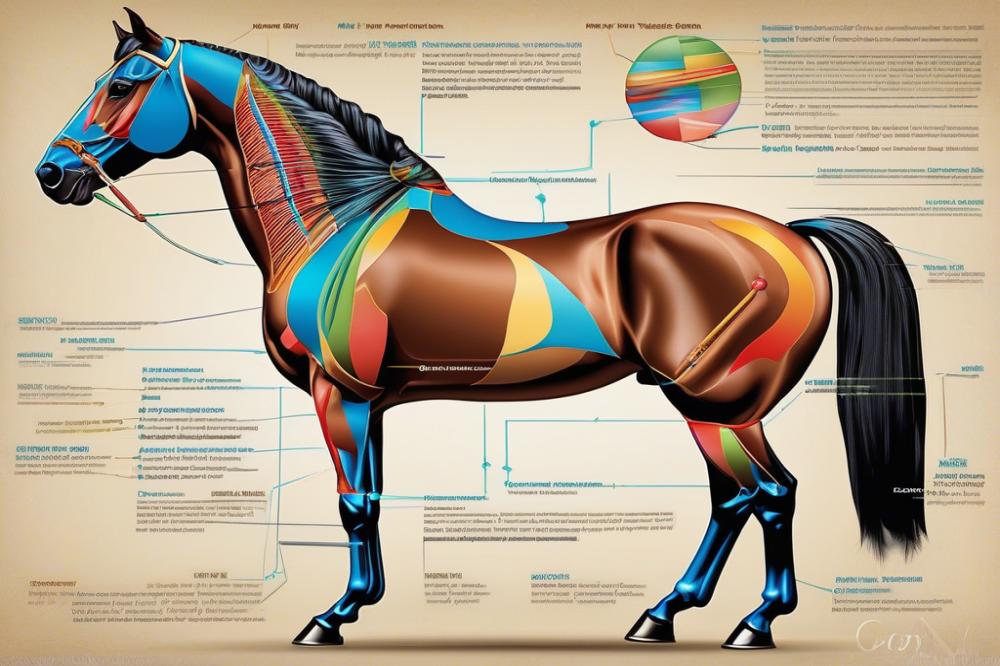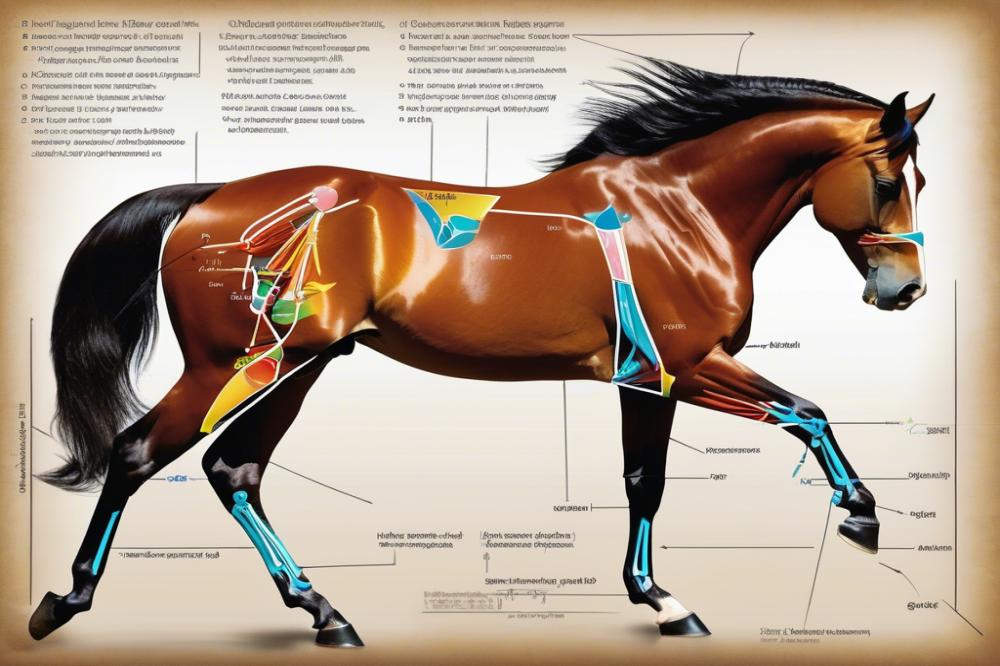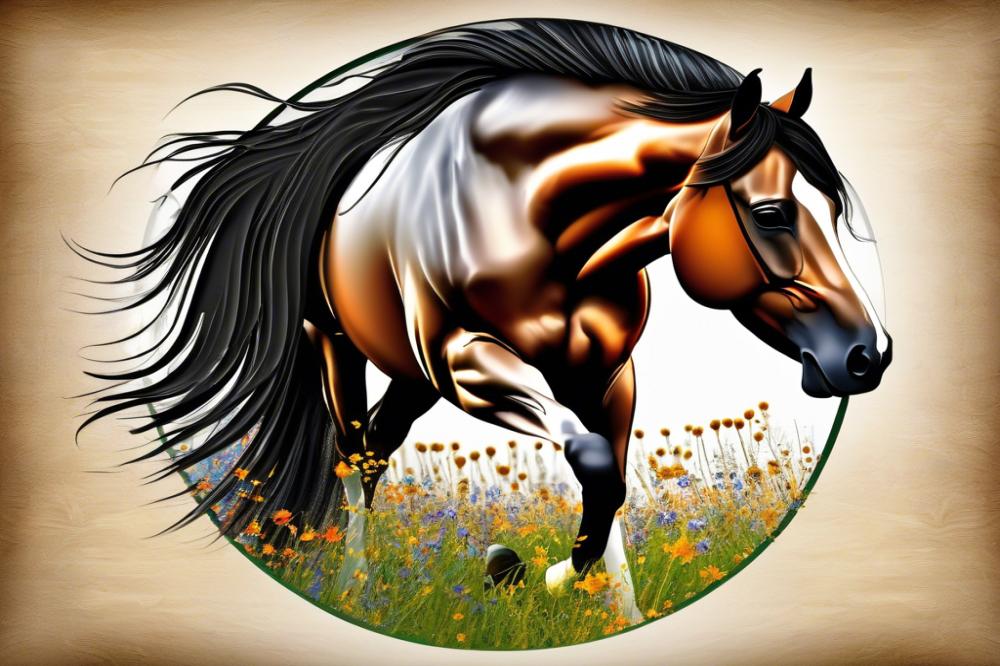Introduction
The intricate tapestry of a horse’s structure is a marvel of natural engineering. Observing an equine’s frame reveals a profound interplay between its muscles, bones, and organs. This seamless integration creates a creature capable of impressive agility and strength. Understanding horses-digest-food-understanding-the-equine-digestive-system”>horses-digest-food-understanding-the-equine-digestive-system”>equine anatomy is crucial for anyone engaged with these magnificent animals. Knowledge regarding their physical makeup is invaluable, whether it pertains to health care, performance, or general well-being.
Equally important is the realm of equine physiology, which delves into the biological processes governing a horse’s life functions. Physiological responses determine how a horse performs under various conditions, impacting everything from heart rate to muscle fatigue. The brave spirit of a horse is matched only by the complexity of its anatomy and bodily functions. Enthusiasts often underestimate how these components interact, leading to both extraordinary capabilities and vulnerabilities.
Similar to a finely-tuned machine, every part of a horse’s body is essential for its operation. From the powerful legs that propel it forward to the sensitive skin that can detect a fly landing, understanding these details can unlock a wealth of insights. Each structure has not only a purpose but a profound impact on its overall performance and care. Appreciating the nuances of equine anatomy and physiology equips caretakers and riders alike with the tools for a successful relationship with their equine partners.
Equine Anatomy

Equine anatomy serves as the foundation for understanding the structure and function of horses. This knowledge is crucial for veterinarians, trainers, and anyone interested in the welfare of these magnificent creatures. Understanding how horses are built helps in diagnosing issues and preventing injuries.
Overview of the Skeletal System
The skeletal system forms the framework of the horse’s body. It consists of a complex arrangement of bones, which vary in structure and function. Horses have approximately 205 bones, though this number can differ based on breed and individual variations. Bones in the horse’s body are classified into several types: long, short, flat, irregular, and sesamoid bones. This variety allows for different roles, such as supporting weight and enabling movement.
Unfortunately, the equine skeletal structure can suffer from injuries. Common skeletal injuries include fractures, splints, and other conditions often resulting from high-impact activities. These injuries can sideline a horse, affecting both performance and well-being. Awareness of such issues helps caretakers provide better rehabilitation and preventative care.
Overview of the Muscular System
The muscular system works hand-in-hand with the skeletal system, playing a pivotal role in movement. Horses have three types of muscles: skeletal, smooth, and cardiac. Skeletal muscles are the ones that allow for voluntary movements and are responsible for the horse’s agility and power. Meanwhile, smooth muscles help regulate involuntary processes, while cardiac muscles keep the heart pumping.
Muscles play an essential role in equine biomechanics. Proper muscle function ensures that a horse can perform optimally while minimizing the risk of injury. In essence, the balance of strength and flexibility helps horses in their athletic endeavors. The way a horse moves is not merely a display of muscle; it tells a story of coordination, balance, and strength.
Comparison of Horse Anatomy to Other Animals
When comparing horse anatomy to that of other animals, significant differences emerge. For instance, the horse possesses a long, powerful leg structure suited for speed and endurance. In contrast, animals like dogs have more versatile limb construction, allowing for quick turns and agility. This variance underscores the specialization of each species; horses excel at long-distance running while other animals might dominate in short bursts.
equine physiology

Physiology in horses encompasses the intricate functions and processes that maintain their health and performance. Understanding this subject is crucial for anyone who interacts with these remarkable animals. Whether you are a trainer, owner, or veterinarian, a grasp of equine physiology can elevate your approach to care and training.
Overview of the Respiratory System
The respiratory system of a horse is designed to support intensive physical activity. Horses breathe in through their nostrils, where air travels down the trachea and into the lungs. Oxygen enters the bloodstream while carbon dioxide is expelled. This mechanism is not just efficient; it’s essential for peak performance. Anytime a horse exerts itself, the demand for oxygen skyrockets.
Healthy lungs are vital for sustaining high levels of athleticism. If a horse suffers from respiratory issues, the impact on its stamina is immediate. A mere cough can lead to decreased airflow and energy, diminishing performance on the racetrack or in the arena. Respiratory health should never be overlooked, as it directly influences how well a horse can perform.
Overview of the Cardiovascular System
Circulation plays a crucial role in delivering nutrients and oxygen throughout a horse’s body. The heart, a muscular organ, pumps blood through an extensive network of arteries and veins. It features a unique structure that can adapt to the horse’s activity level, ensuring efficient blood flow. With each beat, the heart sends oxygen-rich blood to the muscles, priming them for action.
The importance of a horse’s cardiovascular efficiency cannot be overstated. An athlete with a robust circulatory system will often outperform those with compromised heart health. Just as a well-tuned engine enhances a vehicle’s performance, a strong heart contributes to an equine athlete’s success.
Overview of the Digestive System
Digestion in horses is a fascinating and complex affair. These animals are designed to be continuous grazers, thriving on a diet of fibrous plants. Their digestive systems are remarkably efficient, converting forage into energy. The process begins in the mouth, where chewing breaks down food, and continues through a lengthy intestinal tract. This anatomical arrangement allows for maximum nutrient absorption.
Nevertheless, issues can arise. Common ailments include colic and laminitis, both of which can stem from dietary mismanagement. Monitoring a horse’s diet and ensuring it aligns with their needs is critical. Preventative care and knowledge about digestive health can save a horse from discomfort or worse.
Biomechanics of Horses

Explanation of Equine biomechanics
Understanding the biomechanics of horses illuminates the incredible complexity of their movement. This field studies forces and motions that occur within a horse’s body, particularly during locomotion. Muscles, tendons, joints, and bones all work together to create a symphony of motion, producing elegant and powerful strides. Each element plays a crucial role; a slight misalignment can throw the whole system out of whack. Mastery of these principles is essential not only for riders and trainers but also for veterinarians.
Movement Patterns and Gait Analysis
Equine locomotion comprises distinct patterns that reveal much about the horse’s health and performance. Observing gait can provide insights into underlying issues and training effectiveness. Gaits fall mainly into a few categories: walk, trot, canter, and gallop. Each gait exhibits unique mechanical patterns.
During the walk, a four-beat gait showcases a rhythmic sequence that allows for stability. The trot features a two-beat diagonal gait, where pairs of limbs move in unison, created with powerful spring-like actions. Meanwhile, the canter is a three-beat gait and can appear smooth or choppy depending on the horse. The gallop rushes forward with speed, characterized by a distinct four-beat pattern. Such intricacies reflect the profound importance of biomechanics in training and performance evaluations.
Understanding biomechanics supports optimal training regimens, allowing horses to reach their maximum potential while minimizing injury risk. When riders align their techniques with their horse’s natural mechanics, improved performance often follows. For instance, knowing how a horse moves helps tailor exercises that enhance strengths and address weaknesses.
Influence of Anatomy on Biomechanics
Anatomical structures heavily influence how horses move. Each breed is crafted by unique evolutionary history and selective breeding, resulting in distinctive physical traits. Structural adaptations often dictate a horse’s capacity for speed and endurance. For instance, longer legs tend to facilitate greater strides, thus contributing to velocity.
Additionally, the overall musculoskeletal configuration impacts balance and agility significantly. A horse bred for endurance may have different limb proportions compared to one bred for sprinting. This anatomical design not only affects the efficiency of each gait but also influences how a horse bears weight and distributes force while moving.
A glance at their hooves reveals another crucial aspect. Strong, well-formed hooves support not just movement but also absorb shock, which reduces the risk of injury and enhances performance longevity. All these factors weave together to showcase how anatomy and biomechanics form an intricate tapestry, influencing every gallop and turn.
In training horses, comprehending this connection can transform how riders approach their work. Riders who recognize the nuances can adjust their training regimens accordingly. Thus, ensuring a horse’s well-being is paramount to achieving peak performance. After all, a happy horse is often a successful one.
Equine Health and Veterinary Science
Role of anatomy and physiology in equine health
Equine health heavily relies on the understanding of anatomy and physiology. Each organ system plays a vital role in maintaining overall wellness. Muscles, bones, and circulatory systems work in harmony, allowing horses to perform optimally. Knowledge about these structures aids in identifying abnormalities that could hint at underlying issues. The way a horse moves can often indicate discomfort, which is where the nuances of anatomical comprehension come into play. Observing a horse’s posture or gait can yield clues that an untrained eye might miss. After all, horses may not always be forthcoming about their aches and pains.
Importance of regular veterinary examinations
Regular visits from a veterinarian can be the difference between a healthy horse and one that suffers from chronic ailments. You know the saying, “A stitch in time saves nine”? Well, it’s especially true in the equine world. Preventative care allows for early intervention when potential issues arise. Through routine check-ups, veterinarians can catch problems before they escalate, saving both the horse and owner from future headaches. Such examinations typically include checks of vital signs, dental evaluations, and joint flexibility assessments. These details provide comprehensive insights that contribute to the horse’s longevity and quality of life.
Preventative care and early detection of injuries
Taking a proactive approach to equine health often means valuing preventative care. An ounce of prevention is worth a pound of cure, and this adage rings true when it comes to injuries. For instance, conditions like colic can develop silently, only to rear their heads suddenly. By promoting early detection through routine examinations, horse owners can avoid the more gruesome realities of neglect. Injury can easily sneak up on even the most vigilant of caretakers. Just like how a small crack in a tire can lead to a blowout, minor concerns can snowball without proper observation.
Anatomical and physiological considerations in treatment
Understanding both anatomy and physiology guides effective treatment strategies. When surgical interventions become necessary, a detailed knowledge of the horse’s structure is paramount. Efforts during surgery require precision to avoid damaging critical areas. Recovery following such procedures hinges upon the horse’s body’s natural healing capabilities. For example, soft tissue recovery can be much more delicate than a bone fracture. Their unique physiology demands tailor-made rehabilitation protocols, which makes follow-up care just as crucial as the operation itself.
Many aspects of treatment rely on the horse’s own physical responses. Monitoring healing often means keeping a watchful eye on wound sites or behavioral changes. A quick glance might reveal significant information about how well a horse is recovering. Fostering a comfortable environment aids in recovery, as stress can impede healing. Keeping things light and supportive can make recovery a tad less daunting for both horse and human.
Equine Training and Performance
Application of Anatomy and Physiology in Training Programs
Understanding the intricacies of the horse’s muscular and skeletal system is pivotal for creating effective training strategies. Anatomy serves as a roadmap, guiding trainers in structuring exercises that promote strength and flexibility. Each horse presents a distinct combination of physical traits that influences training regimens. Knowledge of joint mechanics plays a critical role in determining suitable activities for different breeds and individual horses. Exploring how muscles function can yield insights into building endurance. Trainers can tailor programs that align with a horse’s natural abilities, thus maximizing potential.
Understanding Physical Limitations Based on Muscular and Skeletal Structure
It’s crucial to recognize that every horse possesses inherent limitations defined by its biological construction. Some horses might excel in agility where others struggle, based on their structural attributes. The conformation of a horse directly impacts performance capabilities. For instance, shorter legs can hinder speed, while longer limbs may aid in reaching greater strides. Trainers must assess these variances carefully; pushing a horse beyond its physical limits can result in injury. A fine balance must be struck between challenging the horse and respecting its boundaries. Ignoring the laws of physics can lead to regrettable outcomes.
Techniques for Optimizing Horse Performance Through Scientific Understanding
Harnessing scientific understanding allows trainers to squeeze every drop of performance from their horses. Conditioning routines can be enhanced by incorporating principles from physiology and biomechanics. For example, interval training is beneficial for building cardiovascular capacity without overextending muscles. Additionally, ensuring proper nutrition is vital for sustaining energy levels during intense training periods. Hydration cannot be overlooked, as it plays a significant role in a horse’s ability to recover. Every detail matters; even the shape of the saddle can influence a horse’s movement and comfort. A little tinkering here and there can lead to noticeable changes on the track.
Wrapping Up Insights on the Horse’s Biology
Grasping the complexity of a horse’s body is akin to becoming fluent in a beautifully intricate language. This organic marvel boasts systems working harmoniously, designed by millions of years of evolution. Advanced machinery, from muscular structure to the respiratory system, plays a crucial role in the vitality of the animal. Each element, from the rhythmic beat of the heart to the swift movement of legs, serves a purpose. Understanding these mechanisms is imperative for anyone involved in caring for or studying these animals.
Scrutinizing their balance and movement reveals a profound relationship between anatomy and functionality. These creatures, often viewed simply as companions or working animals, embody an evolutionary masterpiece. For instance, horse breeds, each with distinctive traits, highlight how genetics fine-tunes their physical attributes. Such insights ignite curiosity among equine enthusiasts. By exploring the world of horses, one can appreciate the nuances in their design.
Moreover, delving into their visual perception, one finds that a horse’s eyes are crafted for wide-range visibility. Their unique field of vision operates like a panoramic camera, assisting in detecting potential threats on the horizon. For a deeper understanding of how these animals perceive the world, studying biomechanics proves invaluable.
In summary, the multidimensional aspects of these animals’ make-up illustrate their evolutionary prowess. Knowledge in this field enriches the experiences of trainers, owners, and vets alike. As a takeaway, embracing education about these majestic animals strengthens our ability to care for them. Join the discourse and expand your understanding by signing up for more information at this link.



